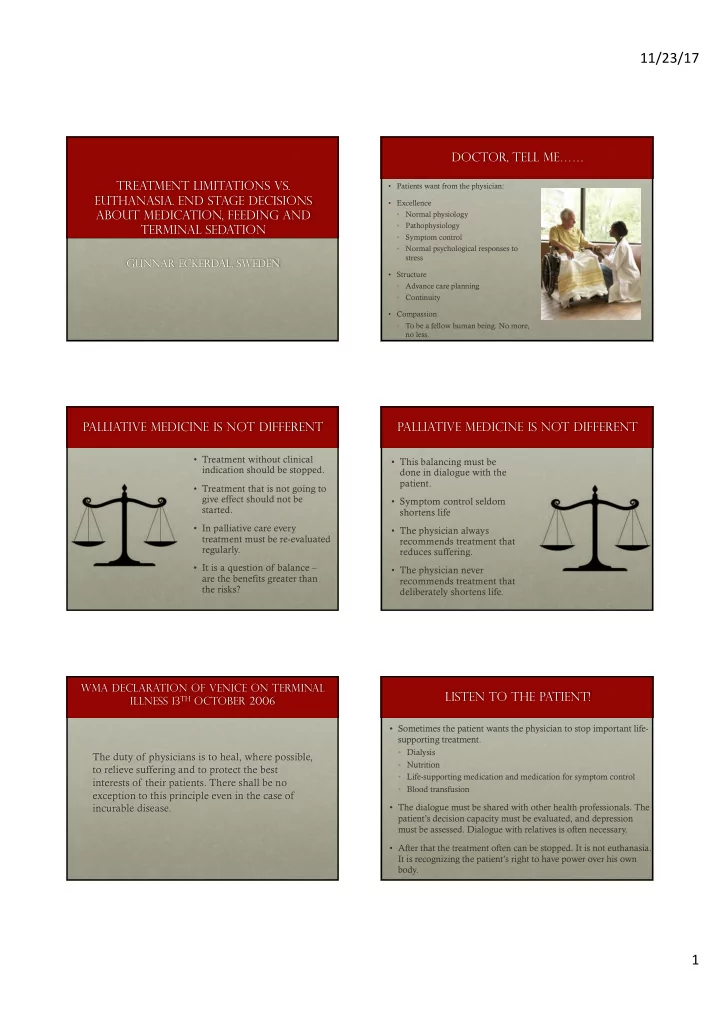

11/23/17 Doctor, tell me…… Treatment limitations vs. • Patients want from the physician: euthanasia. End stage decisions • Excellence about medication, feeding and • Normal physiology • Pathophysiology terminal sedation • Symptom control • Normal psychological responses to stress Gunnar Eckerdal, sweden • Structure • Advance care planning • Continuity • Compassion • To be a fellow human being. No more, no less. Palliative medicine is not different Palliative medicine is not different • Treatment without clinical • This balancing must be indication should be stopped. done in dialogue with the patient. • Treatment that is not going to give effect should not be • Symptom control seldom started. shortens life • In palliative care every • The physician always treatment must be re-evaluated recommends treatment that regularly. reduces suffering. • It is a question of balance – • The physician never are the benefits greater than recommends treatment that the risks? deliberately shortens life. WMA DECLARATION OF VENICE ON TERMINAL listen to the patient! ILLNESS 13 TH OCTOBER 2006 • Sometimes the patient wants the physician to stop important life- supporting treatment. • Dialysis The duty of physicians is to heal, where possible, • Nutrition to relieve suffering and to protect the best • Life-supporting medication and medication for symptom control interests of their patients. There shall be no • Blood transfusion exception to this principle even in the case of incurable disease. • The dialogue must be shared with other health professionals. The patient’s decision capacity must be evaluated, and depression must be assessed. Dialogue with relatives is often necessary. • After that the treatment often can be stopped. It is not euthanasia. It is recognizing the patient’s right to have power over his own body. 1
11/23/17 WMA DECLARATION OF VENICE ON TERMINAL Nutrition ILLNESS 13 TH OCTOBER 2006 • In palliative care the goal is to nourish as much as the metabolism needs. ……The patient’s right to autonomy in decision-making must be respected with regard to decisions in the • If the patient is artificially nourished, terminal phase of life. This includes the right to refuse there is a risk that too much nutrients treatment and to request palliative measures to relieve will not be used by the patient’s metabolism – they do not reach the suffering but which may have the additional effect of cell metabolism, but degrade in the accelerating the dying process. However, physicians are body into products that cause nausea ethically prohibited from actively assisting patients in and in some cases confusion. suicide. This includes administering any treatments • In the palliative care team this calls for whose palliative benefits, in the opinion of the physician, assessment every day. do not justify the additional effects…… • Nutrition by mouth is always preferable – very low risk of overfeeding. Terminal sedation Palliative sedation in sweden • The indication is always symptom control. • The treatment is most commonly used intermittently. • Continuous sedation with doses that makes the patient permanently unconscious is very rare. It is only used when all other treatment has failed. • Severe delirium is the most common indication. • It is not an alternative to euthanasia. • Eckerdal G, Birr A, Lundström S. Palliativ sedering är ovanlig inom specialiserad palliativ vård i Sverige. Läkartidningen. 2009 106:1086-8 How about decision-making What about prognosis? capacity? Days between writing prescription and death, Oregon DWDA patients, 1998-2015 Valid Cumulative Frequency Percent Percent Percent 92,1 Less than 183 days 1380 92 92,1 100 183 days or more 119 7,9 7,9 Unknown 1 0,1 1500 100 In Oregon >7,9 % of the estimates of time to death was wrong. Ref: OREGON DEATH WITH DIGNITY ACT: 2015 DATA SUMMARY 2
11/23/17 suicide - cancer Can suicide be a rational act? ”Cancer patients carry an increased risk of suicide. However, this risk peaks with the month following diagnosis. Clinicians should be aware of this increased risk and include assessments of mood state and suicidality at the time of initial diagnosis of the malignancy and be prepared to provide referral to mental health treatment providers.” Johnson TV , Garlow SJ, Brawley OW , Master VA. Peak window of suicides occurs within the first month of diagnosis: implications for clinical oncology. Psychooncology. 2012 Apr;21(4):351-6 Depression can be treated in palliative care! WHO (2014): 3
11/23/17 Security and efficacy Conclusion • In the palliative team we listen • PAS/euthanasia is not secure to each patient. • Wrong diagnosis • We practice evidensbased • Wrong prognosis medicine as in other specialities. • Underdiagnosed and undertreated depression • A ”No” to some of the patient´s • PAS/euthanasia is not efficient wishes is necessary…. • The patient´s condition is better addressed with • …to protect other patients from treatment that does not shorten life harm. • Together we in almost every situation come to an acceptable agreement. conclusion • My guess is that 20% of all PAS/euthanasia- actions are made after wrong assessments. • Can we accept that patients with help from their doctors commit suicide on wrong grounds? • PAS/euthanasia is not safe! 4
Recommend
More recommend